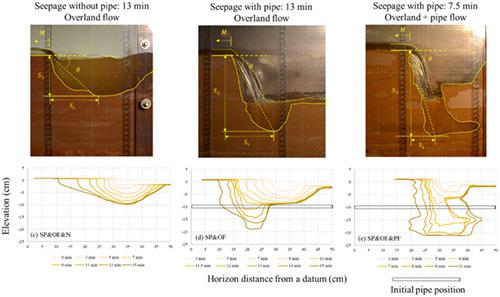当前位置:
X-MOL 学术
›
Earth Surf.Process. Land.
›
论文详情
Our official English website, www.x-mol.net, welcomes your
feedback! (Note: you will need to create a separate account there.)
The role of soil pipe and pipeflow in headcut migration processes in loessic soils
Earth Surface Processes and Landforms ( IF 2.8 ) Pub Date : 2020-03-14 , DOI: 10.1002/esp.4843 Ximeng Xu 1, 2, 3 , Glenn V. Wilson 3 , Fenli Zheng 1 , Qiuhong Tang 2
Earth Surface Processes and Landforms ( IF 2.8 ) Pub Date : 2020-03-14 , DOI: 10.1002/esp.4843 Ximeng Xu 1, 2, 3 , Glenn V. Wilson 3 , Fenli Zheng 1 , Qiuhong Tang 2
Affiliation

|
Headcut formation and migration was sometimes mistaken as the result of overland flow, without realizing that the headcut was formed and being influenced by flow through soil pipes into the headcut. To determine the effects of the soil pipe and flow through a soil pipe on headcut migration in loessic soils, laboratory experiments were conducted under free drainage conditions and conditions of a perched water table. Soil beds with a 3‐cm deep initial headcut were formed in a flume with a 1.5‐cm diameter soil pipe 15 cm below the bed surface. Overland flow and flow into the soil pipe was applied at a constant rate of 68 and 1 l min−1 at the upper end of the flume. The headcut migration rate and sediment concentrations in both surface (channel) and subsurface (soil pipe) flows were measured with time. The typical response was the formation of a headcut that extended in depth until an equilibrium scour hole was established, at which time the headcut migrated upslope. Pipeflow caused erosion inside the soil pipe at the same time that runoff was causing a scour hole to deepen and migrate. When the headcut extended to the depth of the soil pipe, surface runoff entering the scour hole interacted with flow from the soil pipe also entering the scour hole. This interaction dramatically altered the headcut processes and greatly accelerated the headcut migration rates and sediment concentrations. Conditions in which a perched water table provided seepage into the soil pipe, in addition to pipeflow, increased the sediment concentration by 42% and the headcut migration rate by 47% compared with pipeflow under free drainage conditions. The time that overland flow converged with subsurface flow was advanced under seepage conditions by 2.3 and 5.0 min compared with free drainage conditions. This study confirmed that pipeflow dramatically accelerates headcut migration, especially under conditions of shallow perched water tables, and highlights the importance of understanding these processes in headcut migration processes. © 2020 John Wiley & Sons, Ltd.
中文翻译:

黄土中土管和管流在顶切迁移过程中的作用
有时由于误入土地流而误认了地cut的形成和迁移,但并未意识到地cut已形成,并受到通过土壤管进入地cut的水流的影响。为了确定土壤管和流经土壤管的水土流对黄土土壤的迁移的影响,在自由排水条件和高位地下水位条件下进行了实验室实验。在水槽下方15 cm处形成直径为1.5 cm的土壤管,形成具有3 cm深的初始切口的土壤床。以68和1 l min -1的恒定速率施加地面流量和流入土壤管的流量在水槽的上端。随着时间的推移,测量了地表(通道)和地下(下水道)流的截割迁移率和沉积物浓度。典型的响应是形成一个深度扩大的顶部切口,直到建立了一个平衡的冲刷孔为止,此时该顶部切口向上坡迁移。在径流导致冲刷孔加深和迁移的同时,管道流动引起了土壤管内部的侵蚀。当顶部切口延伸到土壤管的深度时,进入冲刷孔的地表径流与来自土壤管的水流也进入冲刷孔。这种相互作用极大地改变了顶切过程,并大大加快了顶切迁移速率和沉积物浓度。栖息的地下水位渗入土壤管的条件,与管道相比,在自由排水条件下,与管道相比,泥沙浓度增加了42%,截流迁移率增加了47%。与自由排水相比,在渗流条件下,陆上水与地下水汇合的时间提前了2.3和5.0分钟。这项研究证实,管道流动显着加速了顶蚀迁移,尤其是在浅水位地下水位条件下,并强调了在顶蚀迁移过程中理解这些过程的重要性。分级为4 +©2020 John Wiley&Sons,Ltd. 与自由排水条件相比,为0分钟。这项研究证实,管道流动显着加速了顶蚀迁移,尤其是在浅水位地下水位条件下,并强调了在顶蚀迁移过程中理解这些过程的重要性。分级为4 +©2020 John Wiley&Sons,Ltd. 与自由排水条件相比,为0分钟。这项研究证实,管道流动显着加速了顶蚀迁移,尤其是在浅水位地下水位条件下,并强调了在顶蚀迁移过程中理解这些过程的重要性。分级为4 +©2020 John Wiley&Sons,Ltd.
更新日期:2020-03-14
中文翻译:

黄土中土管和管流在顶切迁移过程中的作用
有时由于误入土地流而误认了地cut的形成和迁移,但并未意识到地cut已形成,并受到通过土壤管进入地cut的水流的影响。为了确定土壤管和流经土壤管的水土流对黄土土壤的迁移的影响,在自由排水条件和高位地下水位条件下进行了实验室实验。在水槽下方15 cm处形成直径为1.5 cm的土壤管,形成具有3 cm深的初始切口的土壤床。以68和1 l min -1的恒定速率施加地面流量和流入土壤管的流量在水槽的上端。随着时间的推移,测量了地表(通道)和地下(下水道)流的截割迁移率和沉积物浓度。典型的响应是形成一个深度扩大的顶部切口,直到建立了一个平衡的冲刷孔为止,此时该顶部切口向上坡迁移。在径流导致冲刷孔加深和迁移的同时,管道流动引起了土壤管内部的侵蚀。当顶部切口延伸到土壤管的深度时,进入冲刷孔的地表径流与来自土壤管的水流也进入冲刷孔。这种相互作用极大地改变了顶切过程,并大大加快了顶切迁移速率和沉积物浓度。栖息的地下水位渗入土壤管的条件,与管道相比,在自由排水条件下,与管道相比,泥沙浓度增加了42%,截流迁移率增加了47%。与自由排水相比,在渗流条件下,陆上水与地下水汇合的时间提前了2.3和5.0分钟。这项研究证实,管道流动显着加速了顶蚀迁移,尤其是在浅水位地下水位条件下,并强调了在顶蚀迁移过程中理解这些过程的重要性。分级为4 +©2020 John Wiley&Sons,Ltd. 与自由排水条件相比,为0分钟。这项研究证实,管道流动显着加速了顶蚀迁移,尤其是在浅水位地下水位条件下,并强调了在顶蚀迁移过程中理解这些过程的重要性。分级为4 +©2020 John Wiley&Sons,Ltd. 与自由排水条件相比,为0分钟。这项研究证实,管道流动显着加速了顶蚀迁移,尤其是在浅水位地下水位条件下,并强调了在顶蚀迁移过程中理解这些过程的重要性。分级为4 +©2020 John Wiley&Sons,Ltd.











































 京公网安备 11010802027423号
京公网安备 11010802027423号